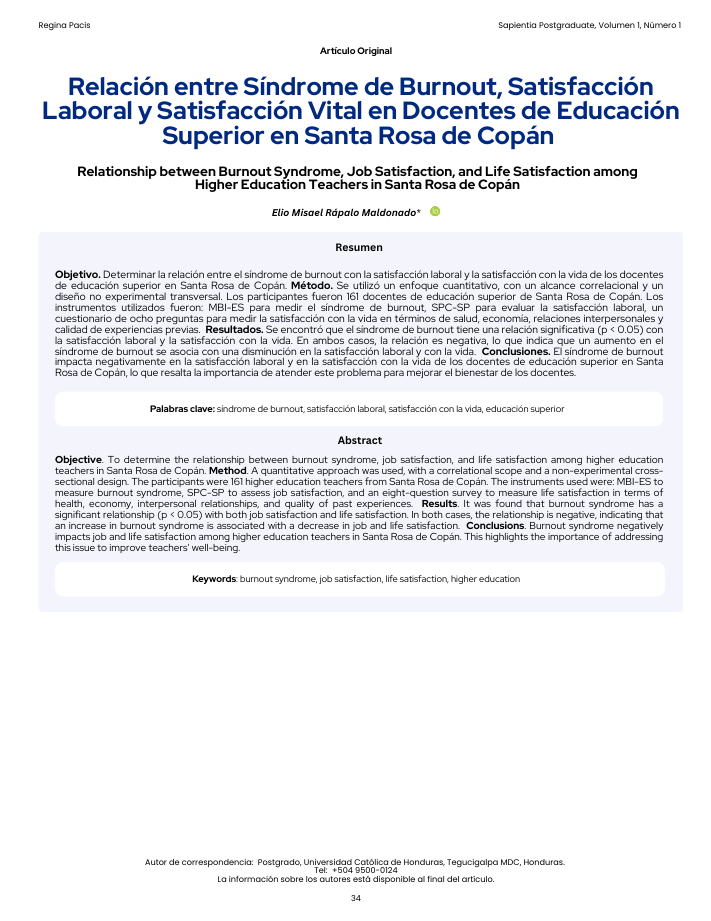Relationship between Burnout Syndrome, Job Satisfaction, and Life Satisfaction among Higher Education Teachers in Santa Rosa de Copán

Published 2025-03-28
Keywords
- Burnout syndrome,
- Job satisfaction,
- Life satisfaction,
- Higher education
Downloads
How to Cite

This work is licensed under a Creative Commons Attribution-NonCommercial-NoDerivatives 4.0 International License.
Abstract
Objective. To determine the relationship between burnout syndrome, job satisfaction, and life satisfaction among higher education teachers in Santa Rosa de Copán. Method. A quantitative approach was used, with a correlational scope and a non-experimental cross sectional design. The participants were 161 higher education teachers from Santa Rosa de Copán. The instruments used were: MBI-ES to measure burnout syndrome, SPC-SP to assess job satisfaction, and an eight-question survey to measure life satisfaction in terms of health, economy, interpersonal relationships, and quality of past experiences. Results. It was found that burnout syndrome has a significant relationship (p < 0.05) with both job satisfaction and life satisfaction. In both cases, the relationship is negative, indicating that an increase in burnout syndrome is associated with a decrease in job and life satisfaction. Conclusions. Burnout syndrome negatively impacts job and life satisfaction among higher education teachers in Santa Rosa de Copán. This highlights the importance of addressing this issue to improve teachers' well-being.
References
- Organización de las Naciones Unidas. (2024). Impacto Académico. https://www.un.org/es/impacto-acad%C3%A9mico/educaci%C3%B3n-superior#:~:text=La%20educaci%C3%B3n%20superior%20permite%20a,sus%20comunidades%20y%20del%20mundo.
- Organización de las Naciones Unidas para la Educación, la Ciencia y la Cultura. (2024). La contribución instituciones de educación superior a los ODS. https://www.iesalc.unesco.org/la-contribucion-de-las-instituciones-de-educacion-superior-a-los-ods/
- Bevoc, L. (2017). Satisfacción laboral, efectos sobre la motivación de los empleados, el rendimiento y el pago. NutriNiche System LLC.
- Naciones Unidas. (1966). Pacto Internacional de Derechos Económicos, Sociales y Culturales. https://www.ohchr.org/es/instruments-mechanisms/instruments/international-covenant-economic-social-and-cultural-rights
- Esteras, J., Chorot, P., y Sandín, B. (2018). El Síndrome de Burnout en los Docentes. Pirámide.
- Gil-Monte, P. R. (2005). El síndrome de quemarse por el trabajo (burnout). Pirámide.
- Maslach, C. (2009). Comprendiendo el Burnout. Ciencia y trabajo, (32), 37-43. https://www.researchgate.net/publication/41126168_Comprendiendo_el_Burnout
- El-Sahili González, L. F. (2015). Burnout. Consecuencias y soluciones. El Manual moderno.
- Shaufeli, W., y Enzmann, D. (1998). The Burnout Companion to Study and Practice. Taylor and Francis.
- Maslach, C., y Jackson, S. (1981). The measurement of experienced burnout. Journal of occupational behaviour, 2(2), 99-113. https://doi.org/10.1002/job.4030020205
- Hermosa Rodríguez, A. (2006). Satisfacción Laboral y Síndrome de Burnout en profesores de educación primaria y secundaria. Revista colombiana de Psicología, (15), 81-89. https://www.redalyc.org/pdf/804/80401509.pdf
- Yslado Méndez, R. M., Norabuena Figueroa, R. P., Loli Poma, T. P., Zarzosa Marquez, E., Padila Castro, L., Pinto Flores, I., y Rojas Gamboa, A. (2019). Síndrome de burnout y la satisfacción laboral en profesionales de la salud. https://doi.org/10.24265/horizmed.2019.v19n4.06
